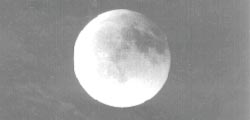Moon illusions
 on any full moon day, the sight of the moon rising over the horizon is truly awesome. The reddish disc seems far bigger than when it is up in the sky. The size of the moon is the same, but for some reason, once it is up in the sky, its size seems to diminish. Scientists have known this "moon illusion" since the time of Aristotle and conjectured on the reasons for this effect. Now, two researchers have established the cause for this illusion.
on any full moon day, the sight of the moon rising over the horizon is truly awesome. The reddish disc seems far bigger than when it is up in the sky. The size of the moon is the same, but for some reason, once it is up in the sky, its size seems to diminish. Scientists have known this "moon illusion" since the time of Aristotle and conjectured on the reasons for this effect. Now, two researchers have established the cause for this illusion.
The fact that the whole thing is an optical illusion is clear. After all the angular size of the moon - the angle subtended by its opposite edges remains the same as it rises up in the sky. To explain this effect, several theories have been proposed. One such theory suggests that the Moon's apparent size is modified because of a feature in our visual perception where the eye has a different focusing distance when viewing an elevated Moon than when the horizontal one.
This is not so weird, because our brain adjusts for distances automatically all the time. When we see distant buildings, we perceive them as being the same size as nearby ones because the mind adjusts for the fact that the object is distant. But since the moon is so far away can the same phenomenon work in this case? Do we really "see" the moon on the horizon as closer and hence bigger.
Quite the contrary, according to L Kaufman and J Kaufman. They argue that the moon on the horizon appears more distant and the eye rescales the distance to make it appear bigger. In the early sixties, L Kaufman and his co-workers had proposed this idea but it had not been tested. Now, the two have put this idea on an experimental footing with a clever experiment where they can determine how far the moon appears to the eyes.
They created artificial moons in a viewer's field of vision, set against a real sky, by using a display screen developed at ibm to project images of bright moon-like disks on to a partly reflective mirror held up against the sky. Each moon was constructed from two images, separated at precisely the distance that would allow them to merge in the stereoscopic vision of an observer to give an impression of a single moon-like disk at essentially an infinite distance. The observers were then asked to position a second moon so that it is half way between them and the original image. By measuring this distance they can determine how far the original moon appears to the observer.
They find that contrary to our intuition, the mind actually "sees" the moon on the horizon as further and thus rescales the image to make it look bigger than what it actually is, hence leading to the rising moon appearing bigger than one up in the sky ( Proceedings of the National Academy of Sciences , January, 2000, No 97).
